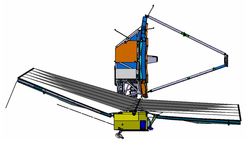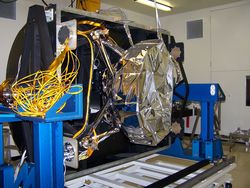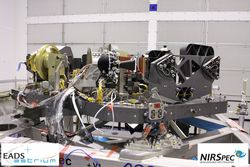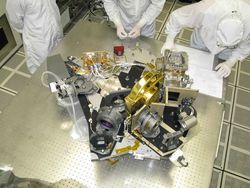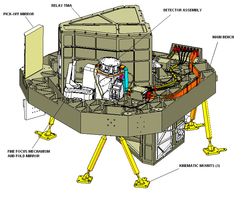Technology
The telescope
The challenges posed by the design and construction of the telescope would be great enough on the ground, but having to be able to get the entire thing into orbit adds another level of complexity. Cutting edge techniques and lightweight materials are key to overcoming these problems, and reliability is a major factor. Hubble orbits close enough to the Earth (some 570km away) that it can be repaired and upgraded as required, however the JWST will occupy a point about 1.5million km distant! Called the Lagrange Point 2, or L2, this is the point where gravitational forces and orbital motion balance each other, allowing JWST and the other space missions at L2 to ‘hover’. L2 lies beyond the orbit of the Earth, and stays lined up with the Earth and the Sun at all times. Advantages include not constantly passing into and out of the Earth’s shadow, meaning the distorting effects of heating and cooling the telescope are removed, plus the heat radiated from the Earth remains far away, resulting in the L2 point being a very stable spot for observations to take place.
The mirror
One of the biggest problems faced in the design of the telescope is the construction of the primary mirror. Using a scaled-up version of Hubble’s mirror would result in something too heavy to get into orbit, as well as being to large to fit inside the launch rocket. Hubble’s primary 2.4 metre diameter mirror weighs 828kg, while the JWST’s 6.5 metre diameter will weigh only about 360kg. Achieving this, and the space constraints, was made possible by the use of 18 hexagonal mirror segments made from beryllium which is both light and strong, each 1.32 metre wide panel weighing about 20kg. The segmented mirror will be launched folded up, and will unfold after launch.
The instruments
MIRI
One of the scientific instruments that will fly on JWST is MIRI, the Mid-InfraRed Instrument. This instrument represents the vast majority of the UK’s involvement in the production of the telescope. MIRI contains a camera and a spectrograph, both of which cover the wavelength range of 5 to 28 microns, or the Mid-Infrared part of the electromagnetic spectrum (which also includes radio, ultraviolet, microwave and xrays as well as the narrow band of visible light which we can see with our eyes.). This wavelength is ideal for observing the light of distant galaxies, newly-forming stars, protplanetary disks and dust warmed by starlight, as well as faintly-visible comets and Kuiper Belt objects. Since MIRI will be looking at what is effectively heat given off by these very distant objects, the entire instrument needs to be very cold. Even though space is cold, it is not cold enough, at about 40K, so the instrument must be actively cooled down to 7K, or 7 degrees above absolute zero, to avoid the heat of the instrument itself giving false readings on the detectors.
You can find out more about MIRI from the STFC Backstage Science MIRI Page
NIRSpec
(ESA) The University of Durham designed and manufactured the image slicer
This instrument will carry out spectroscopy at Near-InfraRed wavelengths (0.6 to 5 microns), which is optimal for objects such as cooler red stars and for seeing through dust which can block other wavelengths of light, thus hiding processes like star formation which happen within the dust. Spectroscopy provides new physical details about the distant object being observed, such as temperature, mass and chemical composition, allowing observers to analyse the gasses in a distant star, for example. Because many of the objects JWST will observe are incredibly faint, the telescope will need to look in one direction for hundreds of hours to gather enough light to form a spectrum, so to make the best use of the projected 5 year mission, NIRSpec can simultaneously observe 100 objects. As such, it will be the first spectrograph in space with this level of capability.
NIRCam
NASA led by the University of Arizona
Just as NIRSpec is the Near-InfraRed Spectrograph, so NIRCam is the Near-InfraRed Camera. It will mainly look at the earliest stars and galaxies in the process of formation, stars in nearby galaxies and young stars within our own galaxy, along with Kuiper Belt objects at the fringes or our solar system. In particular the coronagraphs within NIRCam will allow very faint objects close to bright object to be observed. By blocking out the light from a central bright object, observers will for example be able to determine the characteristics of planets orbiting nearby stars.
FGS-TFI
CSA, led by Hertzerg Institute of Astrophysics & University of Montreal
The Fine Guidance Sensor – Tuneable Filter Imager is the fourth instrument for JWST. It combines two components with different functions, a camera and a ‘guider’ which helps to orientate the telescope, in the same package. The Tuneable Filter Imager is a camera capable of selecting extremely specific wavelengths of light to observe, from the range 1 to 5 microns. It will be used to study currently-forming planetary systems and the disks of dust which could become planets, along with the internal movements of galaxies and the individual components of stellar gas. The Fine Guidance Sensor meanwhile will be used to help with target acquisition, and measuring the telescope’s orientation with relation to pre-selected guide stars at a rate of up to 16 times per second.

